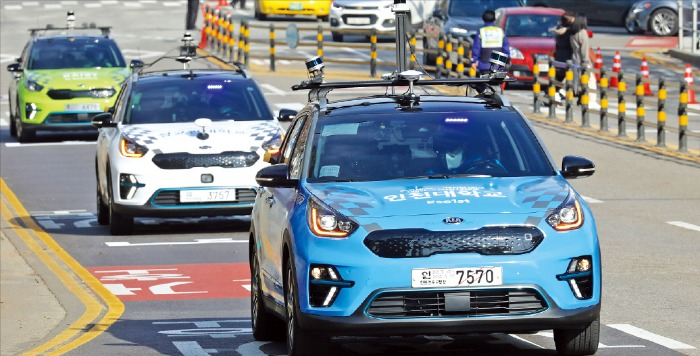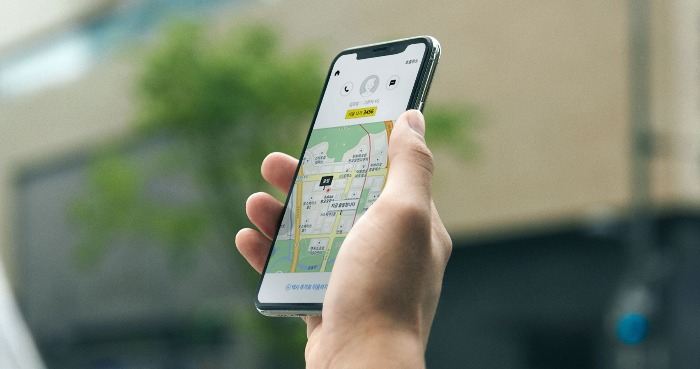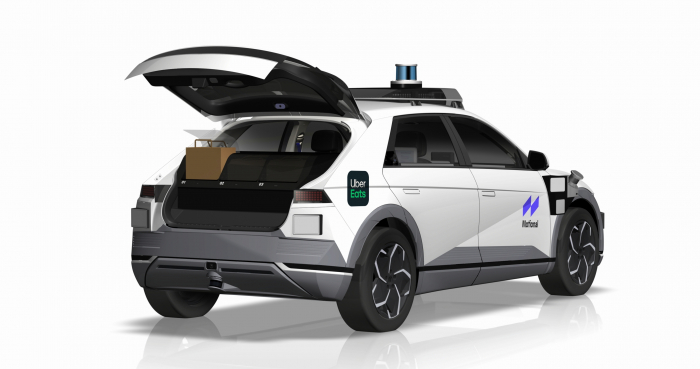Autonomous driving
Hyundai Motor launches robotaxi service in upscale Gangnam district
More than 190 robotaxis receive permits to operate in seven designated pilot zones
By Feb 09, 2022 (Gmt+09:00)
4
Min read
Most Read
LG Chem to sell water filter business to Glenwood PE for $692 million


KT&G eyes overseas M&A after rejecting activist fund's offer


Kyobo Life poised to buy Japan’s SBI Group-owned savings bank


StockX in merger talks with Naver’s online reseller Kream


Meritz backs half of ex-manager’s $210 mn hedge fund



City governments, automakers, and tech giants are leading the adoption of robotaxis in major cities throughout South Korea.
The Ministry of Land, Infrastructure and Transport gave temporary permits to 193 self-driving taxis. There are seven pilot zones where paid self-driving is allowed.
Paid service for robotaxis began late last year in parts of the country’s capital city of Seoul, Gyeonggi Province, Jeju Island and the southern city of Daegu. The vehicles in operation boast either level 3 or level 4 autonomous driving technology, thus from conditional to high automation. There are five levels to driverless mobility – ranging from manual driving to full automation.
ROBOTAXI-HAILING APP
From the Alphadom Tower in Seongnam City, Gyeonggi Province to the nearby Pangyo subway station, there is an eight-lane road.
The lanes are heavy with traffic on a weekday afternoon. Among the cars driving back to back, a black SUV equipped with a camera and a LIDAR (Light Detection And Ranging) blends in rather nicely. The self-driving vehicle is operated by Kakao Mobility Corp., a subsidiary of Kakao Corp., and available to hail through the KakaoT app.
Upon trial, changing lanes was smooth but when the car had to be stopped abruptly, there was a bit of a jerk. All in all, the driverless car drove more smoothly than most novice drivers do, all the while abiding by the legal speed limit of 50 km per hour.
Kakao Mobility provides online taxi-hailing and parking services. The brands include Kakao Taxi, Kakao Driver, and Kakao Navi.

HYDROGEN VEHICLES
The driverless cars can operate as taxis on a 20.4 square km stretch of land that encompasses some of the most popular roads in Seoul’s upscale Gangnam district.
Communication technology based on 5G has shaped the foundation of its infrastructure. The technology feeds changes in traffic signals and remaining time at stoplights to the autonomous vehicle every 0.1 seconds throughout a 24-hour period.
To assist with the process, the Seoul city government shared the traffic signal data at 159 intersections, twice as many as initially planned. This is also the largest such scale in all of the country’s pilot zones.
Hyundai Motors has been accumulating data in the Seoul pilot zone through its hydrogen-fueled electric vehicle Nexo.
The automotive giant will employ the latest technology by Motional, Inc., a joint venture between Hyundai Motor Group and auto supplier Aptiv, headquartered in Boston, Massachusetts.
Hyundai chose the all-electric Hyundai IONIQ 5, developed in conjunction with Motional, as the model to be deployed to the Gangnam district pilot zone.
Even though a safety guard will be on board to assure regulations are abided by, the vehicle boasts level 4 self-driving technology, which does not require physical assistance from human drivers.
Hyundai chose the all-electric Hyundai IONIQ 5 for the Seoul pilot zone.

Seven regions have designated pilot zones for driverless cars, fueling regional competition. In most cases, local governments are working with startups in the autonomous vehicle sectors.
The city of Daegu has been working with startups Sonnet and SWM to launch paid robotaxi services. The pilot zone stretches 4.3 km from Daegu Gyeongbuk Institute of Science and Technology (DGIST.)
In Seoul’s Sangam district, the local government is working with startup 42dot on 5.3 km of road while Jeju-based startup RideFlux Inc. dispatches robotaxis on 38 km of road.
Experts say regulatory change is needed for nationwide adoption.
The Korea Transportation Safety Authority’s senior scientist Shin Jae-gun said, “After the robotaxis achieve a 95 percent level of safety through trial and error, the remaining five percent should be solved through operational design domain (ODD) and securing infrastructure.”
“Restrictions on operation based on weather, traffic and driving speed must be discussed in detail between public and private sectors,” he added.
US & CHINA EXAMPLES
Competition to put autonomous taxis on the road is even fiercer in the United States and China.
General Motors and Honda-backed Cruise have created a public waitlist for its robotaxi service in San Francisco, California.
While Cruise awaits approval to accept payments, the rides will be free. The company has previously only allowed employees to ride in its autonomous vehicles.
Alphabet Inc.'s Waymo, for its part, is currently sticking to a limited service.
Over in China, the government gave the green light to two operators to start charging passengers to use their autonomous taxis in the capital city of Beijing.
Chinese search engine giant Baidu and driverless startup Pony AI were the first companies to be granted such licenses.
Write to See-Eun Lee at see@hankyung.com
Jee Abbey Lee edited this article.
More to Read
-

-
 Korean chipmakersSamsung in talks to supply customized HBM4 to Nvidia, Broadcom, Google
Korean chipmakersSamsung in talks to supply customized HBM4 to Nvidia, Broadcom, Google21 HOURS AGO
-
 EnergyLS Cable breaks ground on $681 mn underwater cable plant in Chesapeake
EnergyLS Cable breaks ground on $681 mn underwater cable plant in ChesapeakeApr 29, 2025 (Gmt+09:00)
-
 Business & PoliticsUS tariffs add risk premium to dollar assets: Maurice Obstfeld
Business & PoliticsUS tariffs add risk premium to dollar assets: Maurice ObstfeldApr 29, 2025 (Gmt+09:00)
-

Comment 0
LOG IN


